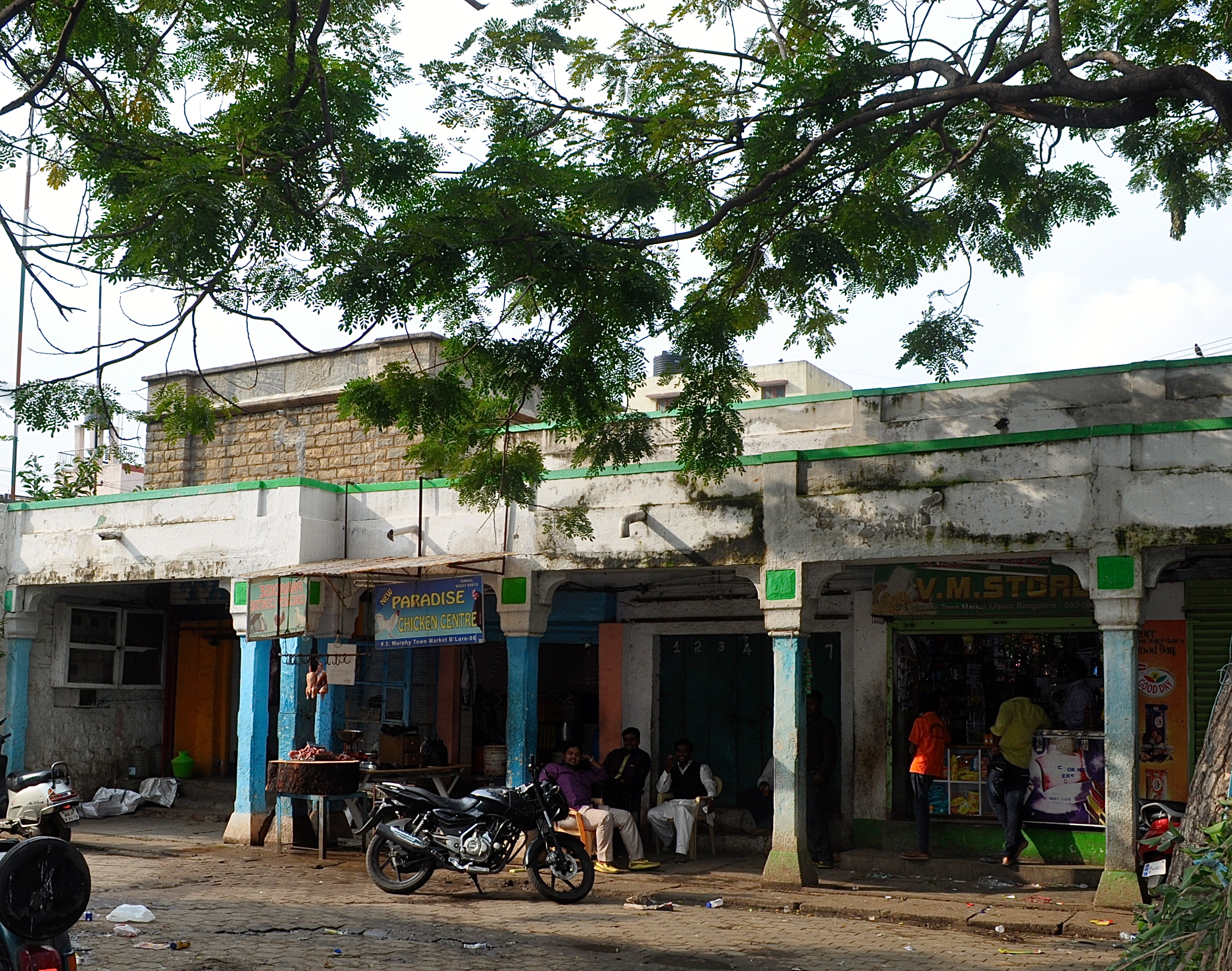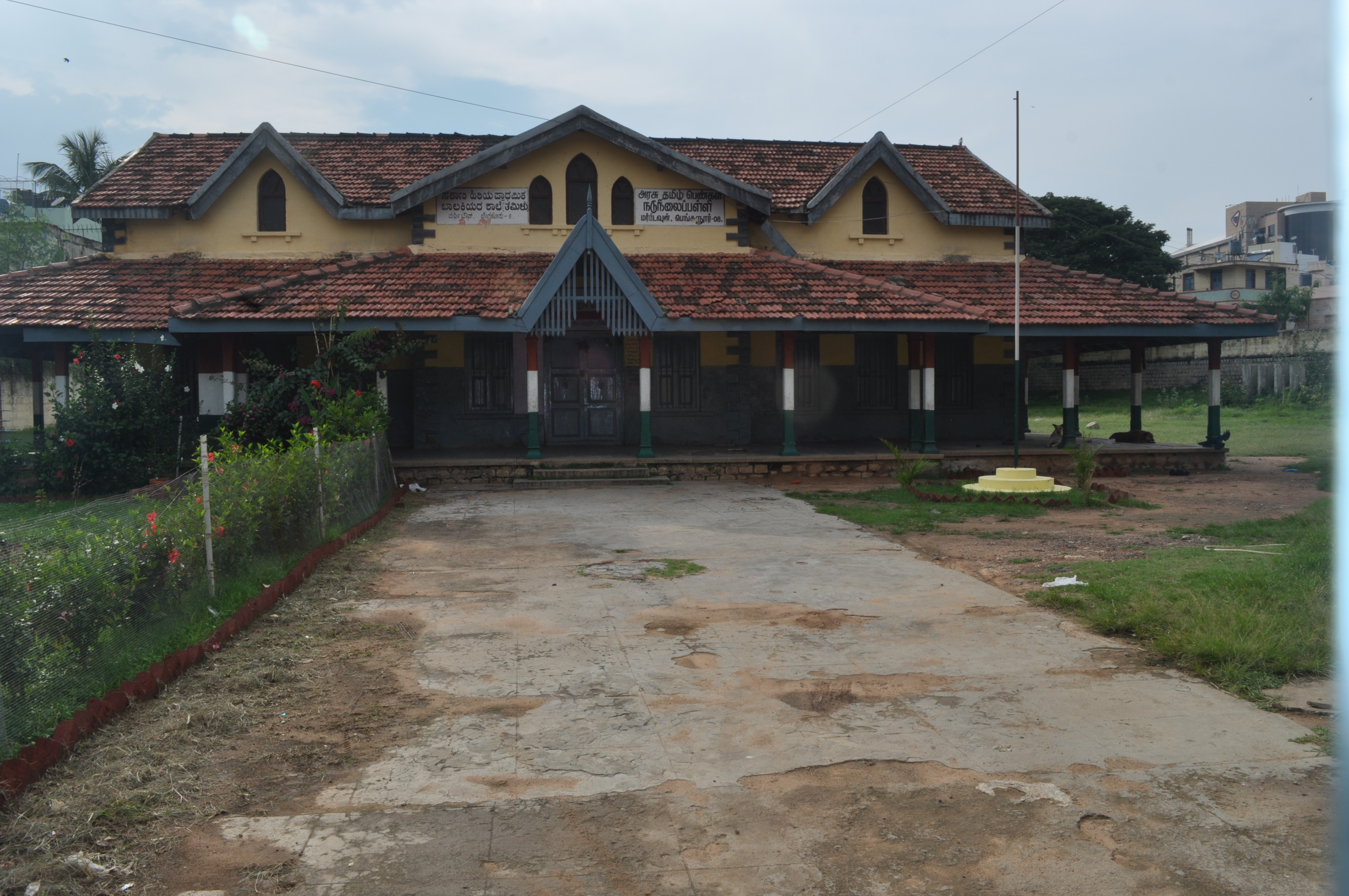The hub of all meat buying and selling in east Bangalore, the market is made up of a bunch of stalls lined up in an orderly U-shape around an open yard. A colonnaded verandah runs in front of the stalls. At the front of the yard, in the hollow of the U and between the two gates of the market, is a small stone government library. The stalls offer chicken, mutton and fish. A separate section of the market is reserved for beef. The 80-year-building served as a daily needs market in colonial times and was used to store grain during emergencies.
The meat market is one of more than 90 structures in the Ulsoor neighborhood identified recently as heritage structures by the Indian National Trust for Art and Cultural Heritage in Bangalore. INTACH is drawing up a comprehensive list of heritage buildings using Ulsoor in the east and Gavipuram in South Bangalore as starting points.
Stalls behind the colonnaded verandah of the Murphy Town meat market.
The Municipal Girls School in Murphy Town is another heritage building. Built in 1924 in the colonial style, the main school block has a high ceiling with wooden framework and Mangalore tiles. The floor is laid with Cuddupah stone slabs.
The colonial-style municipal girls' school in Murphy Town.
Not many people would expect to see 90 heritage structures in crowded and busy Ulsoor. To the layperson, the only historic site in the area is the Someshwara temple. But much of Ulsoor’s heritage lies beyond its public buildings and in its houses. Meera Iyer, co-convener of the Bangalore chapter of INTACH, found that many residences here have traditional elements in their construction – a central courtyard with a water tank around which rooms are arranged, roofs of clay, bamboo or tile, wooden columns and brick masonry.
While the Archeological Survey of India defines heritage as something that is more than a 100 years old, INTACH has been more liberal in applying the term, a factor that has contributed to the length of its list. “When we say heritage that doesn’t just mean something old. It doesn’t mean only a temple or a church or a mosque or a gurudwara,” said Iyer. “It could be a something that gives a street a particular character. It could be something that is unique because of its architectural style.”
INTACH’s list has been compiled after several months of streetwise surveys, identifications and interviews. At a time when many old buildings in Bangalore are being razed for real estate and financial considerations, the conservation NGO wants to use its new listings to get the city’s citizens interested in preserving heritage structures.
Homes as heritage
“Bangalore is not a city of monuments, it is a city of history. It has been a city of very traditional neighbourhoods,” said Sathya Prakash Varanashi, convener of INTACH Bangalore. The reason INTACH’s heritage list is replete with home addresses, street markets and still-in-use schools is because the city’s heritage lies in the neighbourhoods built by people who moved to the city over centuries and the confluence of its subcultures.
Varanashi would like the state government to take notice of INTACH’s list and make a move towards preserving these buildings. So far it has shown little inclination to safeguard the city's history. “For the Karnataka government infrastructure has been a priority, not inheritance. They have gone ahead and built so many new building when it was cheaper to restore old buildings,” Varanashi said.
Suresh Moona, director of An Association for Reviving Awareness about the Monuments of Bangalore Heritage, agrees. “Neither at the administration level or at the government level, nor at the level of the people is there an interest to preserve heritage structures,” rued Moona. Bangalore no longer has a body like the Karnataka Urban Arts Commission, which had some say in regulating construction in sync with existing heritage structures.
While INTACH is hoping to generate some enthusiasm for heritage buildings with an exhibition next month featuring its discoveries in Ulsoor, it is also nervous about revealing the details of the list. "People think that if a building is announced as heritage, there is some motive behind it," said Varanshi, who worries that some structures maybe demolished overnight to avoid 'heritage' regulations. "The only motive can be to document history and preserve the past for our future generations."
For now Bangalore can use INTACH’s norms to start looking for its heritage in what it has considered the ordinary. “The Ulsoor market has still survived after all these years. It hasn’t become a mall,” Iyer points out. “There are still people who buy from shops that have been in existence for more than 50 years.”












